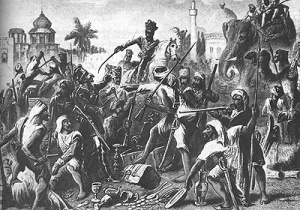Bhai Ram Singh
- Sikhism does not in anyway support the concept of Living human Gurus after Guru Gobind Singh.
- Please DO NOT ADD CONTROVERSIAL INFORMATION to this Page
- Sikhism does not in anyway support the concept of Living human Gurus after Guru Gobind Singh.
Bhai Ram Singh was born in 1826 at village Bhaini in the District of Ludhiana. His father, Jassa Singh, worked as a carpenter in his village. When Bhai Ram Singh grew up, he joined the Khalsa Army and served for several years in the Risala (Cavalry) of Kanwar Nau Nihal Singh, Grandson of Maharaja Ranjit Singh. During his service in the Khalsa he fell under the influence of self-styled Guru Balak Singh and decided to leave the army. His Group saw the excesses of the Maharaja's Darbar as sinful.
In 1857, the year of the Purbia Revolt when both individual Hindu and Muslim units revolted against the British hoping to re-establish their previous rulers and small kingdoms, Bhai Ram Singh had a small revolt of his own in mind, indirectly aimed at the British his efforts were meant to return the Sikhs to what he and his master Balak Singh saw as a more purer form of Sikhism. They founded what was called the Sant Khalsa, which became the nucleus of his Namdhari or Kuka movement. They sought to end any education in the English language using homespun cloth only and eating only vegetarian food cooked by one of their own sects members. Casteism was strictly forbidden. Growing more radical in their beliefs they attacked 'abbatoirs' killing many butchers. Over time they grew more and more radical until their leader Bhai Ram Singh was exiled to Burma.
In 1863, Bhai Ram Singh issued a comprehensive code of discipline for his followers. The code went a long way in consolidating the ranks of the Namdhari also called the Kuka movement.

